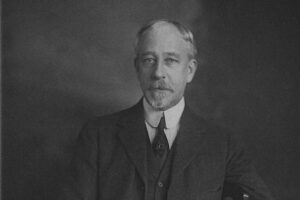No-one in fond on rules, but without them, traffic would be a mess. And it was. So much that an American business man got so annoyed with it that he invented traffic rules. Few remember William Phelps Eno, but you better know his rules.
 Although he never drove a car, William Phelps Eno (1858-1945) developed a deep engagement with traffic from an early age. Only nine years old, holding his mother’s hand, Bill was amazed by the New York traffic jam. A jam of horses and carriages that is, for it was the year 1867, when Henry Ford still was a farmer’s boy. No-one took notice of little Bill these days either, because it would last another 30 years before NYC would get something like traffic regulations. By that time, the mess in the streets was worse than ever and Eno had not forgotten his youth obsession.
Although he never drove a car, William Phelps Eno (1858-1945) developed a deep engagement with traffic from an early age. Only nine years old, holding his mother’s hand, Bill was amazed by the New York traffic jam. A jam of horses and carriages that is, for it was the year 1867, when Henry Ford still was a farmer’s boy. No-one took notice of little Bill these days either, because it would last another 30 years before NYC would get something like traffic regulations. By that time, the mess in the streets was worse than ever and Eno had not forgotten his youth obsession.
He wrote an article, campaigning for legal regulation, communication and enforcement. Next, he wrote his own regulation for New York, Paris and London.
It was about time. Columbus Circle, southwest of Central Park, was stage to a neverending sequence of accidents. Traffic was a total jam in total anarchy. Eno imposed everyone to cross the place in a clockwise circle: the world’s first roundabout was born. Two years later, he did the same at the Arc de Triomphe in Paris and also Picadilly Circus in London was regulated according to Eno’s idea.
Other ideas by William Phelps Eno that we take for granted now are traffic lights, one way traffic, traffic signs, driving on the right, fines, traffic islands, vehicle registration and the driver’s license. During the Great War, Eno was decorated by the French because thanks to his traffic systems, it was possible to transport 60,000 men in time to Verdun, enabling general Pétain to stop off the German march to Paris.
Eno thought of other means of transport as well. He developed an underground network for New York and worked on shipping and railroads. In the 1920 he studied the future development of aviation, for which he predicted a glorious future. The Eno Center of Transportation, an American knowledge center, was his idea. The funny thing is that Eno never drove, because he mistrusted cars.
Yet, Eno was not the only one working on traffic improvement. His compatriot Edward Hines payed his share to the things we take for granted today. In the 1890’s Hines founded the Good Roads Organisation in Michigan, fighting for better country roads, initially for cyclists. Thanks to him and Henry Ford, the first concrete mile was constructed in 1909 in Detroit. Time has it that it was a milkman with a leaking tank that gave him the idea of a center line striping. The snow covering his invention must have frustrated Hines, for he also invented the snow plough.
Does that leave the Dutch, well know as they are for order and rules, without credits in modern traffic? Well, not at all. The Dutch Maus Gatsonides invented the automatic speed trap.